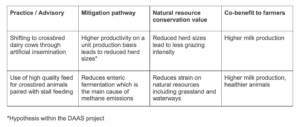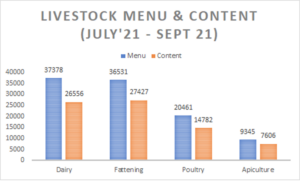To learn more about Digital Green’s AI-powered platform and how it impacts small-scale farmers in India, Ethiopia, Kenya, Nigeria and Brazil, we encourage you to sign up for our newsletter.
Delivering customized and climate smart dairy cattle advisory services in Ethiopia

This blog outlines the Digital Agriculture Advisory Services (DAAS) project’s approach to climate smart livestock advisories. The project is implemented by Digital Green, Precision Development, and the International Food Policy Research Institute (IFPRI), in partnership with the Government of Ethiopia’s Ministry or Agriculture and Agricultural Transformation Agency, and is funded by the Bill and Melinda Gates Foundation and the Foreign, Commonwealth and Development Office.

Tsegaye Ayana, pictured on the left with her dairy cows, lives in the Amhara region of Ethiopia with her husband and seven children. In addition to her cows, Tsegaye also raises oxen and sheep and farms maize. She credits extension services with teaching her how to better care for her animals, and notes that “I learned how to feed dairy cows to increase their milk production. My family works hard and we are able to earn more income from dairy activities. There are customers who buy milk from us and with this, I earn a 6,500 ETB per month income.”
Tsegaye is one of many small-scale producers turning toward livestock as a growing source of income. In Ethiopia the population of cattle, the most popular type of livestock, increased by ~50% from 2004 – 2015 and the total number of livestock owning households increased by over 5 million during that same period. As an important source of income, nutrition, and household resilience, livestock ownership is expected to continue growing as small-scale producers aim to diversify their incomes in response to a changing climate which increasingly affects their ability to rely on annual crop production. These trends represent significant economic opportunities for farmers and show that livestock production should be a priority investment area for governments, non-governmental organizations, and agribusiness actors; however, there is another important aspect to consider – emissions. Globally, livestock production contributes an estimated 14.5% of total GHG emissions, primarily through methane emissions accounting for an equivalent of 7.1 gigatonnes of CO2-eq per annum. In Sub-Saharan Africa, on a per unit basis, milk production is a high contributor to GHG emissions primarily due to enteric fermentation and lack of manure management.
Simple solutions come with complex implementation challenges
There are many practices which can reduce emissions and improve productivity in small-scale livestock production systems. Improving general calf and cow health, enhancing genetic stock through artificial insemination, and providing more digestible fodder all contribute to reduced emissions. Some climate-smart practices can also greatly improve livestock productivity, which is an immediate co-benefit seen by the farmers themselves. Additionally, in accordance with the DAAS project’s climate and nature strategy, we also consider the natural resource conservation or nature improvement value of the practices promoted. Within the DAAS project we have focused our dairy value chain efforts on some of the most impactful dairy husbandry practices, found within the Ethiopian Ministry of Agriculture’s package of practices, for reducing GHG emissions which also offer clear and immediate co-benefits to the farmer. Additionally, some of the practices promoted lead to clear natural resource conservation outcomes. The table below outlines the key dairy husbandry practices promoted within the DAAS project, the mitigation pathway and/or nature positive value, and the co-benefits seen by the farmers.

Although we know the practices in the table above are effective, there are complex implementation challenges which must be addressed in order to effectively promote them. The predominant environment where most small-scale livestock production happens is highly variable. In Ethiopia, despite the large number of government Development Agents delivering crop and livestock training services, the reality is that localized conditions, variability in access to goods and services, and language and structural barriers to information dissemination and uptake make the delivery of these solutions difficult. There is a need to develop information pathways which complement the ability of the extension system to provide more tailored advisory services at a larger scale while capturing data on uptake and results of those interventions.*Hypothesis within the DAAS project
Utilizing technology to customize solutions and overcome barriers
We believe that digital solutions can help overcome implementation and dissemination challenges. Within the DAAS project we are working closely with the Ethiopian Ministry of Agriculture and the Agricultural Transformation Agency to build digital solutions which enhance the ability of the extension system to deliver customized advisory services to small-scale producers. Depending on the value chain or solution being developed, the level of customization can vary from simply ensuring that a recorded phone message is delivered in the right language for a geographic area, to precisely calculating the fertilizer needs for wheat production at the village level. Any level of customization depends on the successful utilization of data and dissemination of information; we are addressing these requirements by developing FarmStack, an open source protocol which facilitates the secure exchange of data to inform advisories, and strengthening digital dissemination channels, such as the ATA’s 8028 IVR push line, to complement the existing government extension package. We are also building a farmer registry and work management application which will be deployed at the Development Agent level via tablets. In short, we are bringing together disparate data sets and filling the existing gaps in those data sets to develop more informed advisory content and then delivering that content via digital channels.
Delivering customized, climate smart advisories to millions of farmers
Within the livestock sector, we’re piloting a number of customized advisories based on the practices outlined in the table above. One key channel is a government managed phone information service (called 8028) which farmers can call from any phone in Ethiopia. Through the 8028 service we’ve been able to reach a significant number of small-scale livestock producers with a variety of content and we are continuing to pilot new use cases through these channels. As shown in the chart below, there is relatively high demand for dairy and beef cattle content from farmers using the 8028 hotline. We are also using this service to “push” advisories directly to farmers via recorded voice messages, which allows for a much higher degree of customization by targeting specific farmers based on predefined criteria such as location, type of livestock, or availability of services in their area.

Number of users accessing livestock content via the Government of Ethiopia’s 8028 service from July – September 2021
The push call advisory interventions are tailored to the individual farmer’s language and location and focus on the following:
- Artificial insemination: This is targeted at AI technicians and dairy farmers in their area in order to: (i) Improve AI technicians efficiency through reminders of the key steps of AI service provision; (ii) increase farmers demand for AI services; and (iii) inform farmers how to identify when the proper time is for AI services (i.e. heat identification);
- Calf and cow management: This promotes key practices for improving calf and cow mortality rates during pregnancy and after giving birth; and
- Location based content: This use case will utilize location data to tailor general messages about feeding practices which are timed to the seasonal availability of feed stocks and local conditions and can greatly reduce enteric fermentation. For example if a farmer in Oromia has heifers and sells milk then the feed advisory to optimize the health and reduce the emissions from the cows in March may be different than another farmer who is raising steers for plowing in SNNPR.
We are actively developing a methodology for measuring the adoption of practices promoted via the 8028 channel which will support our ability to quantify the economic and climate related impacts of these advisories. Early phone survey data indicates that farmers who use the inbound 8028 line often understand and retain the information they learn, but further studies are needed to definitively determine the adoption outcomes from this service. When the final iteration of the adoption methodology is complete and tested, we will release that and update these materials accordingly.
A pathway to scaling climate smart dairy cattle practices in Ethiopia
The DAAS project’s approach to reaching scale, with a target of 3.5 million farmers across all value chains by 2024, is threefold:
- Proof of concept: Develop customized use cases to demonstrate the value of data integration and customization
- System strengthening: Improve digital channels and tools, including video enabled extension, IVR technology, and digitizing extension processes
- Catalyzing the ecosystem: Build an ecosystem of actors utilizing FarmStack to share and combine data to further developed future advisories
What we aim to achieve here is to demonstrate how data sharing and digital tools can complement and strengthen existing extension systems in a scalable and repeatable way which can grow with the dairy sector. By prioritizing climate-smart advisory content and targeting the dairy value chain we are supporting farmers to increase their incomes while mitigating emissions from increased dairy production in Ethiopia.